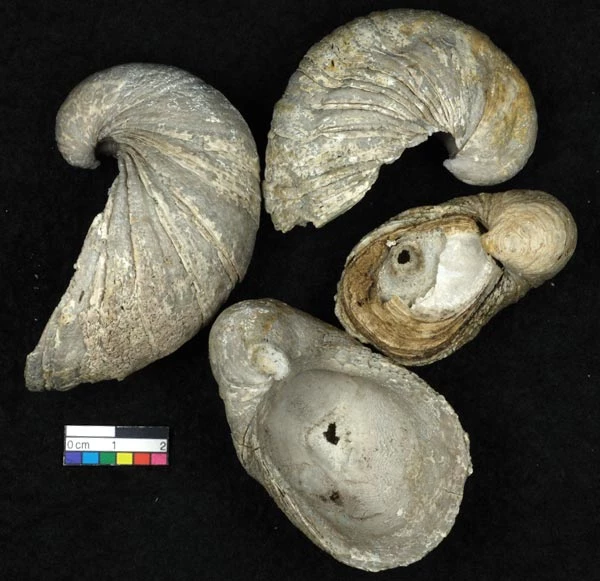Ffosilau mewn carreg: Paratoi ffosilau gydag asid
Calchfaen o Southerndown yn ne Cymru, yn cynnwys cregyn ffosil (Gryphaea arcuata — Ewinedd traed y Diafol).
Cregyn ffosil (Gryphaea arcuata – Ewinedd traed y Diafol) wedi i'r garreg gael ei thoddi mewn asid.
Cragen ddeufalf ffosil sydd ar hanner cael ei pharatoi gan ddefnyddio asid. Mae dwy ran y gragen (y falfiau) yn dal yn sownd i'w gilydd, ac mae'r falf isaf yn dal yn sownd i'r garreg.
Anaml y bydd ffosilau mewn cyflwr perffaith yn cael eu canfod. Pan fyddan nhw'n cael eu casglu, bydd y rhan fwyaf o ffosilau wedi'u cuddio'n rhannol, neu yn llwr, mewn matrics carreg. Er mwyn eu hastudio'n fanwl, neu i'w paratoi ar gyfer arddangos, rhai tynnu'r garreg o'u hamgylch yn ofalus.
Nid gwaith hawdd yw gwahanu carreg galed a ffosilau sydd weithiau'n hynod fregus, a gall fod yn broses hir drafferthus. Byddwn weithiau'n defnyddio offer llaw (pin, sgrafell, cŷn bach), neu gallwn ddefnyddio offer arbennig ar gyfer paratoi ffosilau, fel pinnau niwmatig tebyg i offer engrafu. Dewis arall yw defnyddio peiriant aer-sgreaffinio sy'n debyg i chwythwr tywod bach.
Neu gallwn ni doddi'r garreg mewn asid. Roedd y rhan fwyaf o gregyn ffosil wedi'u gwneud yn wreiddiol o galsiwm carbonad, ac mae nifer wedi'u cadw mewn
calchfaen , sydd â'r un cyfansoddiad cemegol. Weithiau fodd bynnag, mae calsiwm carbonad y gragen yn toddi ymaith a silica yn ffurfio yn ei le, ond gan adael y galchfaen yn gyfan. Fydd y silica ddim yn toddi yn yr asid fel y galchfaen, ac felly gallwn ni dynnu sbesimenau o'r fath o'r garreg yn gemegol.Finegr, dim halen os gwelwch yn dda
Yr asid fydd yn cael ei ddefnyddio gan amlaf fydd asid asetig — yr asid mewn finegr. Rydyn ni'n defnyddio crynodiad hynod uchel o asid asetig (80%), ond yn ei wanhau mewn dŵr i tua 5%.
Yn ystod y broses, bydd sampl carreg yn cynnwys ffosilau yn cael ei throchi yn yr asid asetig wedi'i wanu, fydd yn dechrau sïo bron yn syth wrth i'r asid a'r calchfaen adweithio.
Mae'r amser y bydd y garreg yn cymryd i doddi'n llwyr yn amrywio o rai diwrnodiau i sawl mis, yn dibynnu ar gyfansoddiad penodol y garreg. Bydd yr adwaith â'r garreg yn niwtralu'r asid yn raddol, a bydd angen ei adnewyddu o bryd i'w gilydd. Ymhen amser — oriau, diwrnodau neu wythnosau weithiau — y cyfan sydd ar ôl yw gwarged carreg lleidiog a'r ffosilau wedi siliceiddio.
Mae nifer o ffosilau siliceiddiedig yn frau iawn ac mae angen gofal mawr wrth eu trin. Bydd yn rhaid i ni eu cryfhau yn aml gyda glud i'w gwneud yn fwy cadarn.
Mae'r ffosilau bellach yn barod ar gyfer ymchwil neu arddangosfa. Mae nifer wedi cadw'n hynod o dda; mae rhai cregyn 450-miliwn o flynyddoedd oed sydd wedi'u siliceiddio yn edrych fel petai nhw wedi cael eu codi o'r traeth ddoe!



sylw - (11)
My wife and I just purchased a property in North Texas, about 30 miles west of Fort Worth. We have what looks like the "Devil's toenails" by the hundreds preserved in larger pieces of limestone as well as individual specimens scattered across the surface of our yard. The previous owners had a new septic system installed a couple of years ago so I suspect these were dug up during that process. My daughters and I have been collecting them and setting them aside for further investigation but by the looks of some of the previous comments, they are fairly common in this area. Would love to get more info if possible. Thank you.
Barry
It's amazing to find fossils like this anywhere. I'm afraid that we can't identify or comment about any without good photographs though. If these are from Texas it might be worth you contacting your nearest museum with a geological curator.
Dear Jenny Kenward,
Thank you for getting in touch with us. I have passed your enquiry to my colleagues within the natural sciences department. They will be able to advise further on this.
Many thanks,
Nia
(Digital team)
Hi Cindy,
As a general rule the acid should be refreshed when it stops fizzing. it is all dependent on the type of acid being used and the rock type that you are dissolving.
Kind Regards,
Amanda
(Senior Laboratory Officer (Natural Sciences) - National Museum Wales)